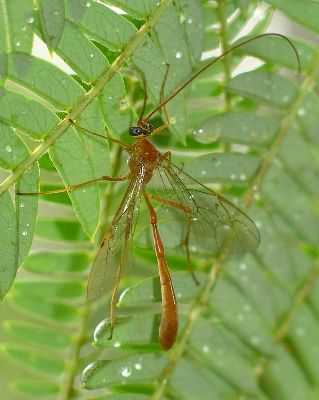by Valerie
December, 2003Short-Tailed Ichneumon
Our featured animal this month is one that I don't see very often. It is a short-tailed ichneumon (Ophion sp.), shown resting on the leaves of a mimosa tree. Related to wasps and sawflies, ichneumons are members of Ichneumonidae, one of the largest insect families, with around 40,000 known species worldwide, over 3000 of which are found in North America. This species of ichneumon looks somewhat like an oversized crane fly or a very slender wasp. It can be distinguished from the former by its four wings (crane flies have only two) and from the latter by its much longer antennae and golden brown color. When most people think of ichneumons, the giant striped kind with the enormous ovipositor comes to mind. The female of that type uses what looks like the most menacing stinger simply to drill into trees to lay eggs on grubs within the wood. The short-tailed ichneumon, on the other hand, obviously doesn't have the long ovipositor. In fact, this species can deliver a "sting" because the short, sturdy structure is not retractible and can be pushed into flesh by an irritated insect. It does not inject venom like a wasp or bee, though. At about an inch long, the short-tailed ichneumons can also bite, so they are best not handled. Ichneumons are considered beneficial as their larvae are parasitic on other insects, especially caterpillars and grubs that are harmful to crops and garden plants. Each species of ichneumon is usually restricted to only a single, or at most a small group, of prey insects. Members of the genus Ophion generally lay their eggs on the grubs of scarab beetles, such as the June beetle and green June beetle. The adult ichneumons eat nectar, plant fluids, pollen and other sugary substances. Although they are common, and there are many species, they are not all that obvious most of the time, tending to be rather secretive and blend in with the surrounding vegetation. |